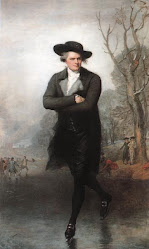 There seems to be a classical statue between the residence and the Schuylkill river; it can be recalled here that it was still common at this time for young men of privilege to undertake the Grand Tour, the educational rite of passage. Visiting Rome was a high priority, and classical artwork was the rage. ( I have no idea if Samuel took such a trip, but this would explain the presence of such artwork.) Three classic tall thin cypress trees would cast soothing shade in the area behind the statue. If one looks closely, the bath house seems to be in the distance on the far side of the house. Under the bridge exists a canal, about which Birch says, "Upon the half ascent of the bank from the river, the new canal will pass the house and if ever finished, will become a great ornament to the place."
There seems to be a classical statue between the residence and the Schuylkill river; it can be recalled here that it was still common at this time for young men of privilege to undertake the Grand Tour, the educational rite of passage. Visiting Rome was a high priority, and classical artwork was the rage. ( I have no idea if Samuel took such a trip, but this would explain the presence of such artwork.) Three classic tall thin cypress trees would cast soothing shade in the area behind the statue. If one looks closely, the bath house seems to be in the distance on the far side of the house. Under the bridge exists a canal, about which Birch says, "Upon the half ascent of the bank from the river, the new canal will pass the house and if ever finished, will become a great ornament to the place."However Emily Cooperman (editor, see below for citation) writes, "One of the principle motives behind the construction of the Schuylkill canal was to enable coal to be transported more readily from upriver. The portion of the canal shown in Birch's view does not survive."
It is almost certain that Samuel used this country estate as a second residence; for leisure activities, as a source to provide fresh foodstuffs, for entertainment (he was a member of the fox hunting club, the stall could hold up to eight horses), to escape the hot summers in the city, and to escape the periodic yellow fever epidemics which swept through Philadelphia every few years.
I speculate that it was here, in this residence, that Samuel and his twin sister Phebe celebrated their 40ieth birthday in 1803, when Samuel gifted his Stuart portrait to his sister. The two large rooms on the bottom floor, and the sprawling scenic grounds would have served very well for an elegant garden party!
"Fountain Green included 25 acres of land "divided into lots " and a "good two-story dwelling house, with two rooms on the first floor, three on the second, and two ceiled garrets; two stone wings, one occupied as a kitchen, the other as a lodging room; a good stone barn, with stable room for eight horses; a frame cow stable, having stalls for seven cows, and hay-loft above; a most excellent spring house, with suitable accomodations for a tenant, or overseer; a plunging bath, covered with a neat frame building, used as a wash house, two good bearing orchards of the best kinds of grafted fruit; highly cultivated [vegetable] gardens, and a variety of different kinds of fruit trees, and grape vines." (taken from the newspaper Claypoole's American Daily Advertiser) The Country Seats of the United States by William Russell Birch, edited & with introduction by Emily T. Cooperman, University of Pennsylvania Press, Philadelphia 2009
~
The non-pretentious air of the residence in terms of architecture (compared to the other country seats as depicted by Birch), the practical uses of the land (for animals, growing food & lodging), the calm bucolic beauty of the landscape.... point to a man who could balance his life between the creation of wealth in the city, and the pursuit of happiness in the undisturbed quiet of nature.













